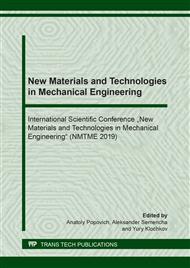[1]
A.T. Kruk, V.F. Fedorkevich. Shtampovka pokovok flantsev truboprovodov na tyazhelykh krivoshipnykh goryacheshtampovochnykh pressakh. Zhurnal «Kuznechno-shtampovochnoe proizvodstvo», 1999, № 6, str. 35 – 40.
Google Scholar
[2]
Tekhnologicheskie vozmozhnosti ob''emnoj shtampovki obkatyvaniem na sferodvizhnompressovatele. Klassifikatsiya protsessov. N. P. Ageev, Zhurnal «Metalloobrabotka» № 5, 2001 g., str. 36 - 44.
Google Scholar
[3]
Gurinovich V.A., Balandin Yu.A., Gurchenko P.S., Kolpakov A.S., Zharkov E.V., Isaevich L.A., Sidorenko M.I. Tortsovaya raskatka detalej flantsevogo tipa. Zhurnal «Avtomobil'naya promyshlennost'» 2005. №9.
Google Scholar
[4]
Shtampovka obkatyvaniem kol'tsevykh i flantsevykh zagotovok / Surkov V. A., Koryakin N. A., Galimov Je. R. // Zagotovitel'nye proizvodstva v mashinostroenii. - 2005, № 7, s. 27-29.
Google Scholar
[5]
Surkov V.A., Koryakin N.A. Tekhnologicheskie protsessy formoobrazovaniya zagotovok detalej gazoturbinnogo dvigatelya metodom shtampovki obkatyvaniem. Zhurnal «Zagotovitel'nye proizvodstva v mashinostroenii», 2008, № 7, s.21-28.
Google Scholar
[6]
NowakJ, MadejL, ZiolkiewiczS, PlewinskiA, GrosmanF, PietrzykM (2008) Recentdevelopmentinorbitalforgingtechnology. Int J Mater Form 1 (Suppl 1):387–390.
Google Scholar
[7]
Han X, Hua L (2009) Comparison between cold rotary forging and conventional forging. J MechSciTechnol 23:2668–2678.
DOI: 10.1007/s12206-009-0624-9
Google Scholar
[8]
Extended application range for orbital forming technology. Schmid Press Release, HeinrichSchmid Machines, Tools & Dies Ltd., Jona, Switzerland, May (2005).
Google Scholar
[9]
Plancak ME, Vilotic DZ, Stefanovic MC, Movrin DZ, Kacmarcik IZ (2012) Orbital forging— a possible alternative for bulk metal forming. J Trends Dev Mach AssocTechnol 16(1):35–38.
Google Scholar
[10]
EN 1092-1. Flanges: https://www.pipefittingweb.com/flange/pdf/en-flange.pdf (accessed 13.12.2018).
Google Scholar
[11]
Montoya I, Santos MT, Pérez I, González B, Puigjaner JF (2008) Kinematic and sensitivity analysis of rotary forging process by means of a simulation model. Int J Mater Form 1 (Suppl 1): 383–386.
DOI: 10.1007/s12289-008-0075-3
Google Scholar
[12]
Liu G, Yuan S, Zhang M (2001) Numerical analysis on rotary forging mechanism of a flange. J Mater SciTechnol 17(1):129–131.
Google Scholar
[13]
Wang GC, Zhao GQ (2002) Simulation and analysis of rotary forging a ring workpiece using finite element method. Finite Elem Anal Des 38(12):1151–1164.
DOI: 10.1016/s0168-874x(02)00056-2
Google Scholar
[14]
Munshi M, Shah K, Cho H, Altan T (2005) Finite element analysis of orbital forming used in spindle/inner ring assembly. In: 8th ICTP 2005—international conference on technology of plasticity, Verona, 9–13 Oct (2005).
Google Scholar
[15]
Kocańda A (2015) Development of orbital forging processes by using Marciniak rocking-die solutions. In: Tekkaya AE, Homberg W, Brosius A (eds) 60 excellent inventions in metal forming. Springer-Verlag, Berlin, Heidelberg, p.319–324.
DOI: 10.1007/978-3-662-46312-3_49
Google Scholar
[16]
Evgrafov A., (ed.). Advances in Mechanical Engineering, Lecture Notes in Mechanical Engineering, Springer International Publishing Switzerland, 2016, pp.175-181, DOI 10.1007/978-3-319-29579-4.
Google Scholar
[17]
Kolbasnikov NG, Bezobrazov YA, Naumov AA. Structural evolution of high-strength dual-phase steel in hot rolling. Steel in Translation. 2013 Jul 1;43(7):455-9.
DOI: 10.3103/s0967091213070085
Google Scholar
[18]
Kolbasnikov NG, Matveev MA, Zotov OG, Mishin VV, Mishnev PA, Nikonov SV. Hot platicity of microalloyed pipe steel in continuous casting and hot rolling. Steel in Translation. 2014 Feb 1; 44(2):149-55.
DOI: 10.3103/s0967091214020089
Google Scholar
[19]
Sokolov D.F, Ogoltcov A.A, Vasilyev A.A, Kolbasnikov N.G, Sokolov S.F. Modeling of microstructure and mechanical properties of hot rolled steels. InMaterials Science Forum 2013 (Vol. 762, pp.116-121). Trans Tech Publications.
DOI: 10.4028/www.scientific.net/msf.762.116
Google Scholar
[20]
Kolbasnikov NG, Matveev MA, Mishnev PA. Effect of structure factor on high-temperature ductility of pipe steels. Metal Science and Heat Treatment. 2016 May 1;58(1-2):51-7.
DOI: 10.1007/s11041-016-9964-0
Google Scholar
[21]
Rudskoi, A.I., Zolotov, A.M., Parshikov, R.A. Severe plastic deformation influence on engineering plasticity of copper. Materials Physics and Mechanics. 2018. Т. 38. № 1. С. 64-68.
Google Scholar
[22]
Parshikov, R.A., Rudskoy, A.I., Zolotov, A.M., Tolochko, O.V. Analysis of specimen plastic flow features during severe plastic deformation. (2016) Reviews on Advanced Materials Science, 45 (1-2), pp.67-75.
Google Scholar


